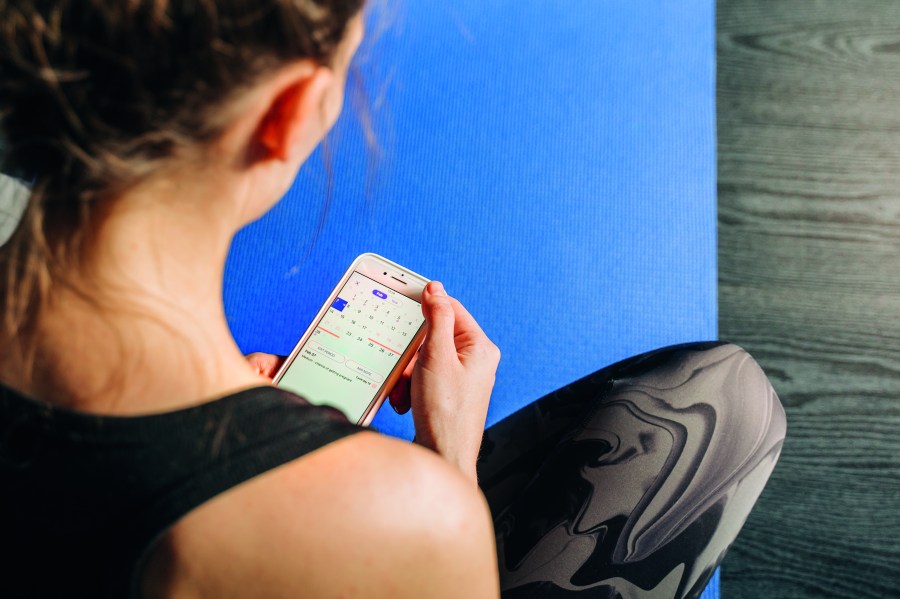It’s possible that you haven’t realised how much your hormones from your period can affect your fitness routine.
Some days you may feel energised and ready to tackle a marathon while on others, getting out of bed seems like a challenge. Personal trainer Kate Rowe-Ham shares how your menstrual cycle affects your energy and training throughout the month, and what to do when.
Phase 1: menstruation
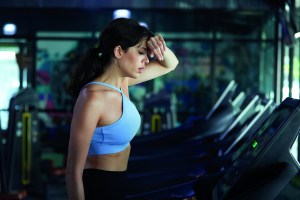
This is the first day of your period. In this first, or reset, phase, your LH (luteinising hormone), oestrogen, progesterone and testosterone – the primary hormones that control your menstrual cycle – are all at their lowest point.
For many women, having their period is not the most comfortable time of the month, and it can bring about numerous symptoms. However, as menstruation gets underway, PMS symptoms subside, your body temperature returns to a more normal level and some of your energy begins to creep back up.
Impact on exercise = LOW ENERGY
You have your period, so you will naturally feel slightly lacking in energy. You might turn up to your regular class but not feel like doing it; or maybe you didn’t do as well as you’d hoped. This is okay, and the reason will be because of your hormones. You are still making progress, but today just isn’t your day – and that is okay.
As you head towards the end of this phase and into the follicular phase, you will feel more capable of exercising, and you’ll be able to add more intensity to your training.
What to do:
Gentle yoga, walking, stretching or Pilates. If you have the energy for high- intensity exercise, go for it.
Phase 2: The follicular phase
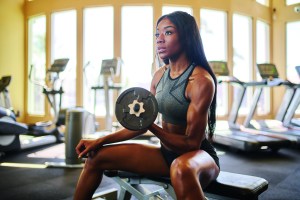
The follicular phase, including the ovulation period, is a great time to start thinking about your progress and strength training. During this time, your body produces more oestrogen. You might feel like you have a higher tolerance for pain or increasing endurance levels due to this steady rise. Your body is also more likely to use muscle glycogen to fuel exercise. Renourish and refuel with high-carb meals before and after your workout to optimise your training and aid recovery.
Impact on exercise = ENERGY INCREASING
Your oestrogen levels are beginning to rise. You may feel your energy increasing and are likely to find exercise more appealing and possible.
What to do:
Now is an excellent time to focus on building muscle as your physical strength is at its best. You may also feel more creative and dynamic, so add some weights to your workout.
Best period-proof activewear for working out
Phase 3: The ovulation phase
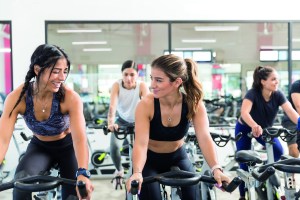
As you ovulate, your strength levels will still be relatively high, and you may even notice this. If you want to get a personal best, now might be the time to try. One study, published in the Journal of Physiology, found ovulating women showed an 11 per cent increase in quadriceps and hand-grip strength.
However, you are also at a higher risk of injury during this time. Your oestrogen, FSH and LH levels reach their peak and your metabolism is beginning to increase as well, so you might feel a bit more peckish. Understanding and addressing this means
that if you do need to add more calories, you can get these from a balanced mix of protein, carbohydrates and fats, rather than sugary alternatives, as your insulin sensitivity is declining.
Impact on exercise = PEAK ENERGY
The release of the egg from the ovary mid-cycle may see you experiencing an increase in energy levels and strength. It is the oestrogen, FSH and LH peak that can cause this increase, allowing you to feel able to put more effort into your workouts.
What to do:
This is an ideal time to do HIIT or Spin classes, maybe even with friends, as you’re also more sociable. Take advantage of your increased strength and train hard, but pay attention to your body, noting how it feels, as it is also a time when injuries can occur. Be sure to warm up and cool down properly.
Phase 4: The luteal phase
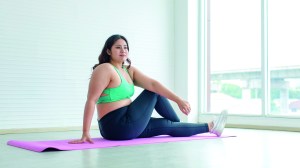
During this phase, your body temperature tends to be higher than normal, and you may find you are reaching the point of exhaustion or feeling more fatigued a little sooner than in the previous weeks. You may also be retaining excess water, making it a little bit more uncomfortable to work out, and you may feel sluggish, too.
Your serotonin production is lower in this phase, so you may find yourself craving high-carbohydrate foods and sugary snacks. Try to be aware of this because your instinct will be to reach for those foods, whereas it would be better to go for foods high in protein to offset these cravings.
Impact on exercise = ENERGY DECLINE
After experiencing a boost in energy and successfully meeting your personal goals, it’s common to suddenly feel like your efforts are not producing the desired outcome, which can lead to decreased confidence. If you feel less energetic, consider engaging in low-intensity cardio training paired with moderate strength exercises. When you’re feeling exhausted and irritable, try adjusting your routine and incorporating activities such as yoga, Pilates, dancing or any other activity that interests you.
Additionally, it’s worth noting that your metabolic rate may have increased, leading to a higher likelihood of craving sugary foods and having an increased appetite.
What to do:
Low-impact steady-state (LISS) exercise, yoga, Pilates, jogging and lighter weights than usual.

